A Server must have a Disk Safe before any backup can be run.
| Notice Disk Safes should always be placed on reliable storage. For more Disk Safe best practices, see Use Disk Safe best practices. |
Follow the instructions below to create a Disk Safe in your Server Backup.
1. In the Main Menu, click Settings and then Disk Safes.
2. On the Disk Safes screen, click the + New Disk Safe button.
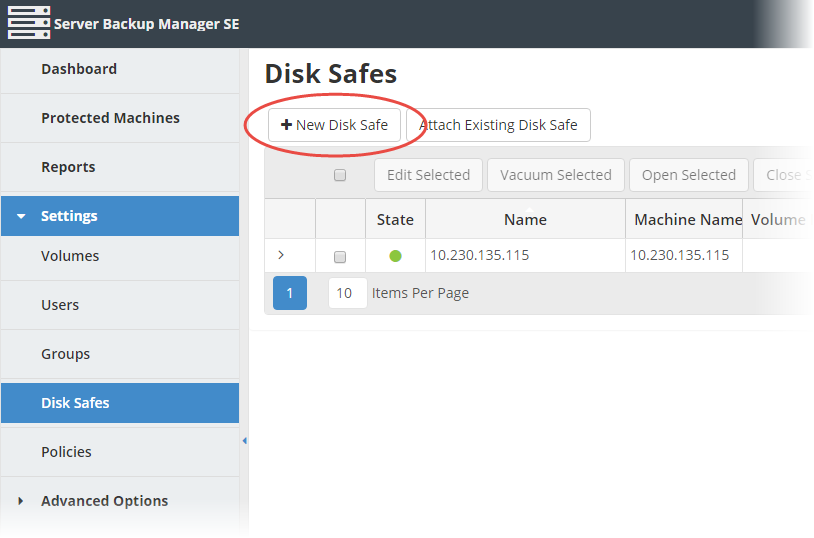
| Note You can also create Disk Safes on the Protected Machines page. For the protected machine for which you need to add a Disk Safe, click the Actions menu and select Create Disk Safe. The Create New Disk Safe window displays, just like on the main Disk Safes screen. See more information in Access servers. 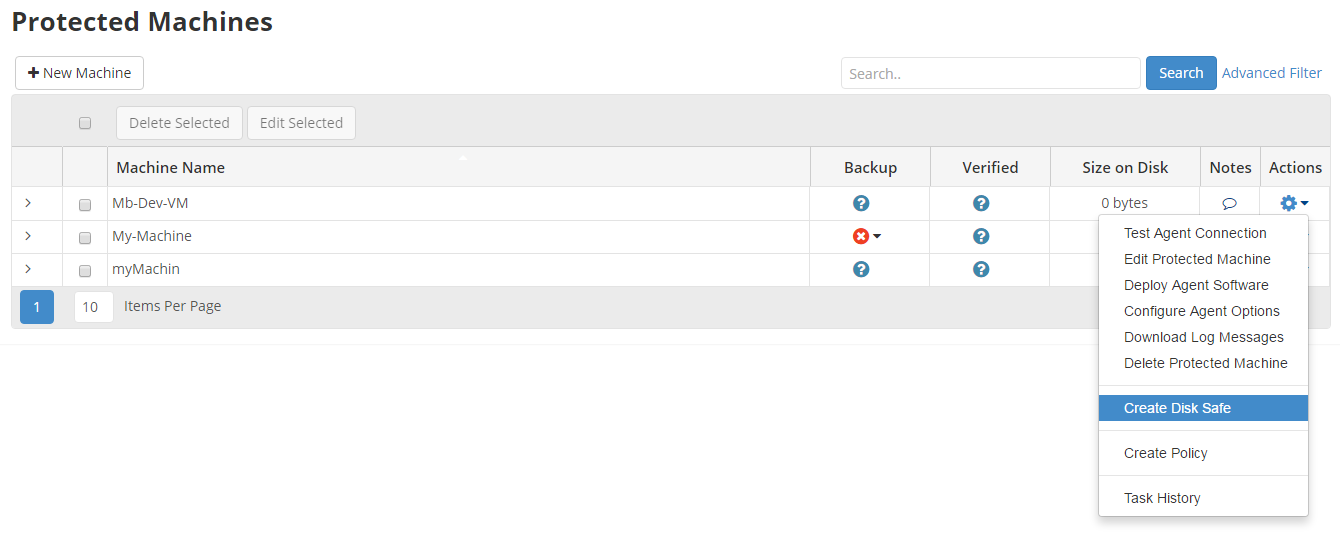 |
3. The following Disk Safe Best Practices window will appear. Read the information and click OK.
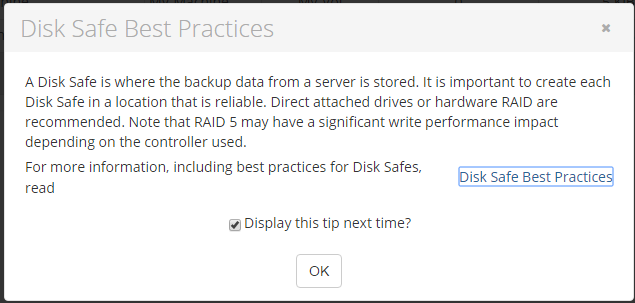
4. The _Create New Disk Safe _window displays.

5. The window contains the following tabs:
- Settings
- Devices
- Data Settings
- Replication
- Limits
6. Define the following settings specific to the new Disk Safe:
Settings Tab
Identification
- Name - Define the name for the Disk Safe. It will be used to identify the Disk Safe in the list.
Protected Machine
- Protected Machine - Select a protected machine from the drop-down menu.
Location
- Assign This Disk Safe to a Volume - Select this check box to assign the new Disk Safe to a specific volume.
- Volume - Select a Volume, which is a storage of one or more Disk Safes with a common Quota and assigned User(s)/Group(s).
- Path - Path where the Disk Safe is physically located, e.g., C:\Disk_Safe. This field displays if the Assign This Disk Safe to a Volume check box is selected.

| Note If the Assign this Disk Safe to a Volume check box is cleared, the Path field displays along with the following message.
|
Devices Tab
- Automatically add new devices - This option will automatically add all available Manage devices to the Disk Safe. Clear the check box to select the devices you want to add to the Disk Safe. If you do not select this option, the "At least one device must be enabled for replication" message will appear once you save the Disk Safe. Read more in Access devices, Add devices.
- Protect Storage Configuration - This option allows you to back up partition tables.
- Devices On Agent pane - This pane provides you with information about devices that currently exist on the host. To view the list of Devices, click the *Get Devices from Agent *button. Also see Access devices.
- Devices In Disk Safe pane - This pane provides you with information about devices that are currently assigned to the Disk Safe. Also see Access devices.
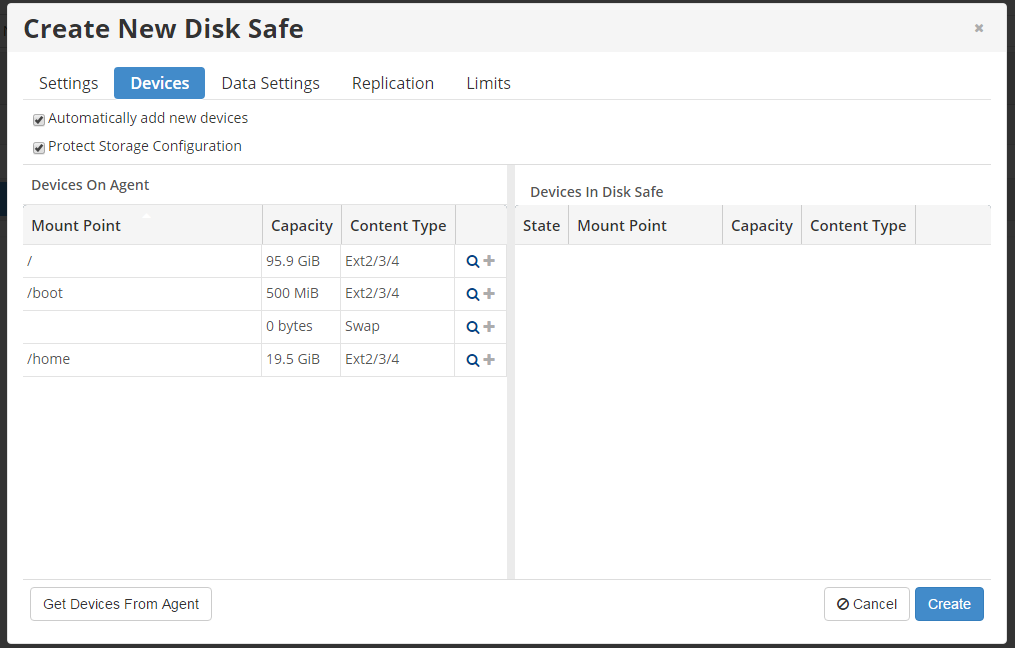
Data Settings Tab
Compression is a process of encoding information using less space than an unencoded representation would use, through use of zlib (also known as gzip) encoding schemes. It helps reduce the consumption of expensive resources, such as hard disk space or transmission bandwidth. Compression is performed at the hard Disk sector level on the Server during a Backup by the Backup Agent.
- Compression Type - The compression type set for the Disk Safe. Possible values:
- None - No compression will be applied. "None" is used to complete backups in the shortest amount of time over fast LANs (Local Area Networks).
- Zlib - The zlib type of compression will be applied. For backups over the Internet or other slow links, we recommend turning compression on. Disk Safes use zlib (also known as gzip-compatible) compression and are capable of delivering about a 2:1 compression ratio in most environments. If this compression type is selected, the Compression Level field displays, where you can select Low, Medium, or High zlib compression levels.
- QuickLZ - Selecting this value means turning the compression on. The QuickLZ type of compression is the fastest compression type, reaching 308 Mbyte/s per core.
In cryptography, encryption is the process of transforming information (referred to as plaintext) using an algorithm (called a cipher) to make it unreadable to anyone except those possessing special knowledge, usually referred to as a key.
- Encryption Type - You can assign an AES 256-Bit encryption to the Disk Safe. In that case, you will be asked to create a password. If you choose to encrypt a Disk Safe, the password must be supplied to do the following: browse files, browse Control Panel users, browse databases, and initiate BMR. Read more in Manage Disk Safe encryption.
| Note Configured during creation, encryption cannot be turned on/off. |

Limits Tab
This tab allows File Excludes, Recovery Point Archiving, and Control Panels to be enabled/disabled. Limits can be defined for Replication, Recovery Points, and Archive Points.
| Tip When you assign a Disk Safe to a volume, all of the Volume's limits are applied to that Disk Safe. That it why the Disk Safe's limits should be at least as restrictive as the Volume's. For example, if a Volume has a Recovery Point limit set to 100, the Disk Safe can only contain 100 Recovery Points or fewer. |
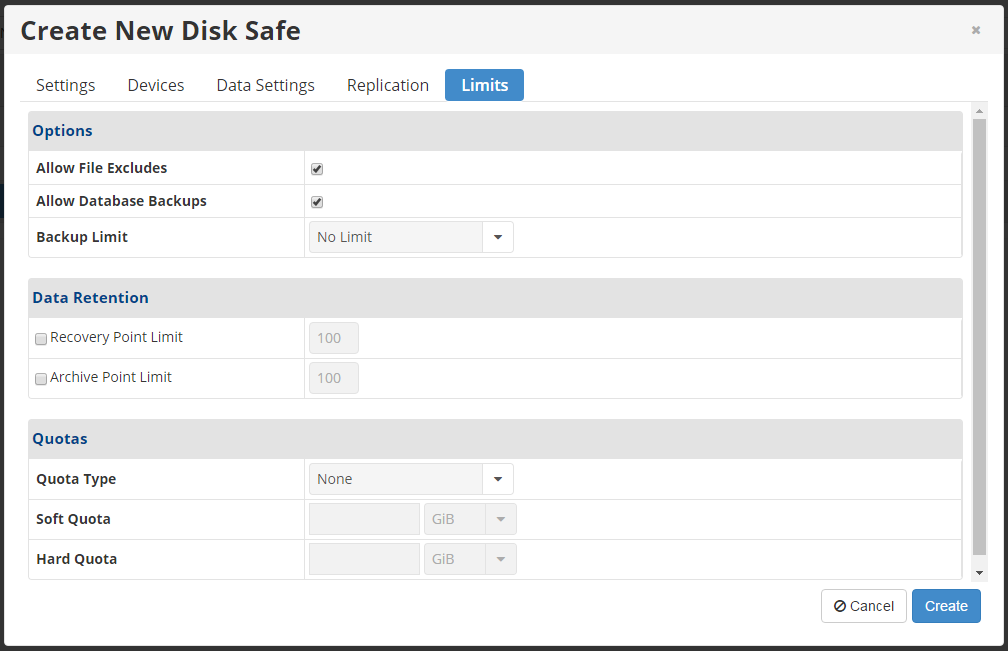
Options
- Allow File Excludes - This option is selected by default. Activates the File Excludes feature for the Disk Safe. If you check this option, you can specify the files/folders which will not be backed up during the replication Policy. By default, all file/folders from the selected Devices are replicated. Read more in About exclusions, Exclude files and folders.

You cannot activate this option if it is not activated for the Volume to which the Disk Safe belongs. - Allow Recovery Point Archiving - This option is selected by default and activates the Archiving feature for the Disk Safe. If you check this option, you can create archives of your data on a specified hour, day, week, or month. If the option is enabled, you can specify the "Archive Point Limit" under "Data Retention." Read more in Offsite Backup and Archival.

You cannot activate this option if it is not activated for the Volume to which the Disk Safe belongs. - Allow Control Panels - This option is selected by default. Activates the Control Panels feature for the Disk Safe. This option allows you to back up and restore Hosting Control Panel user accounts. Read more in Hosting control panels.

Tip
You cannot activate this option if it is not activated for the Volume to which the Disk Safe belongs.
Tip
There is a system-wide option to enable the Hosting Control Panels feature (Configuration Product features "Enable Hosting Control Panels" option under "Hosting Control Panels"). Read more in Enable the Hosting Control Panels feature.
Product features "Enable Hosting Control Panels" option under "Hosting Control Panels"). Read more in Enable the Hosting Control Panels feature. - Allow Database Backups - This option is selected by default. This option allows you to back up and restore all databases available on the Server. If unchecked, the "SQL Server," "Exchange," and "MySQL" tabs are disabled while creating a Policy.
- Backup Limit - This option defines the lowest replication frequency for that Disk Safe. For example, if you set the backup limit to "weekly," then the Policy assigned to that Disk Safe can only be weekly or higher (hourly and daily replications will be restricted).

Tip
The Disk Safe Replication Limit must be within the limits of the Replication Limit of the Volume to which the Disk Safe is assigned.
Data Retention
- Recovery Point Limit - This is the maximum number of Recovery Points that can be stored in the Disk Safe.

Tip
The Disk Safe Recovery Point Limit must be within the limits of the Recovery Point Limit of the Volume to which the Disk Safe is assigned. - Archive Point Limit - This is the maximum number of Archive Points stored in the Disk Safe.

Tip
The Disk Safe Archive Point Limit must be within the limits of the Archive Point Limit of the Volume to which the Disk Safe is assigned.
Quotas
- Quota Type - The type of quota assigned to the Disk Safe. Quotas are set to limit the disk usage of the Disk Safe. The limit is set on the basis of the amount of space occupied by Disk Safes or the size of deltas.
- Soft Quota - The value in bytes or in deltas. Soft Quota is a warning level that informs users that they are close to reaching their effective limit.
- Hard Quota - The value in bytes or in deltas. Hard Quota allows resources to be occupied by data. If the Hard Quota is reached, the system forbids generation of new Recovery Points. The replication is interrupted and fails.
7. Define the necessary Disk Safe properties and click Create.
8. If you have specified a nonexistent directory for the Disk Safe, you are now prompted to create a new directory. Click OK.
9. The new Disk Safe will be created.
Adding the Devices
| Note The Adding Devices procedure is performed in cases when the "Automatically add new devices" option has been unchecked during a Disk Safe creation. Note that this option is enabled by default. |
You can find more information in Add devices.
Viewing Created Disk Safe
The new Disk Safe displays in the Disk Safes list. To view the details of the Disk Safe you just created, click the arrow in the left column for the corresponding Disk Safe. 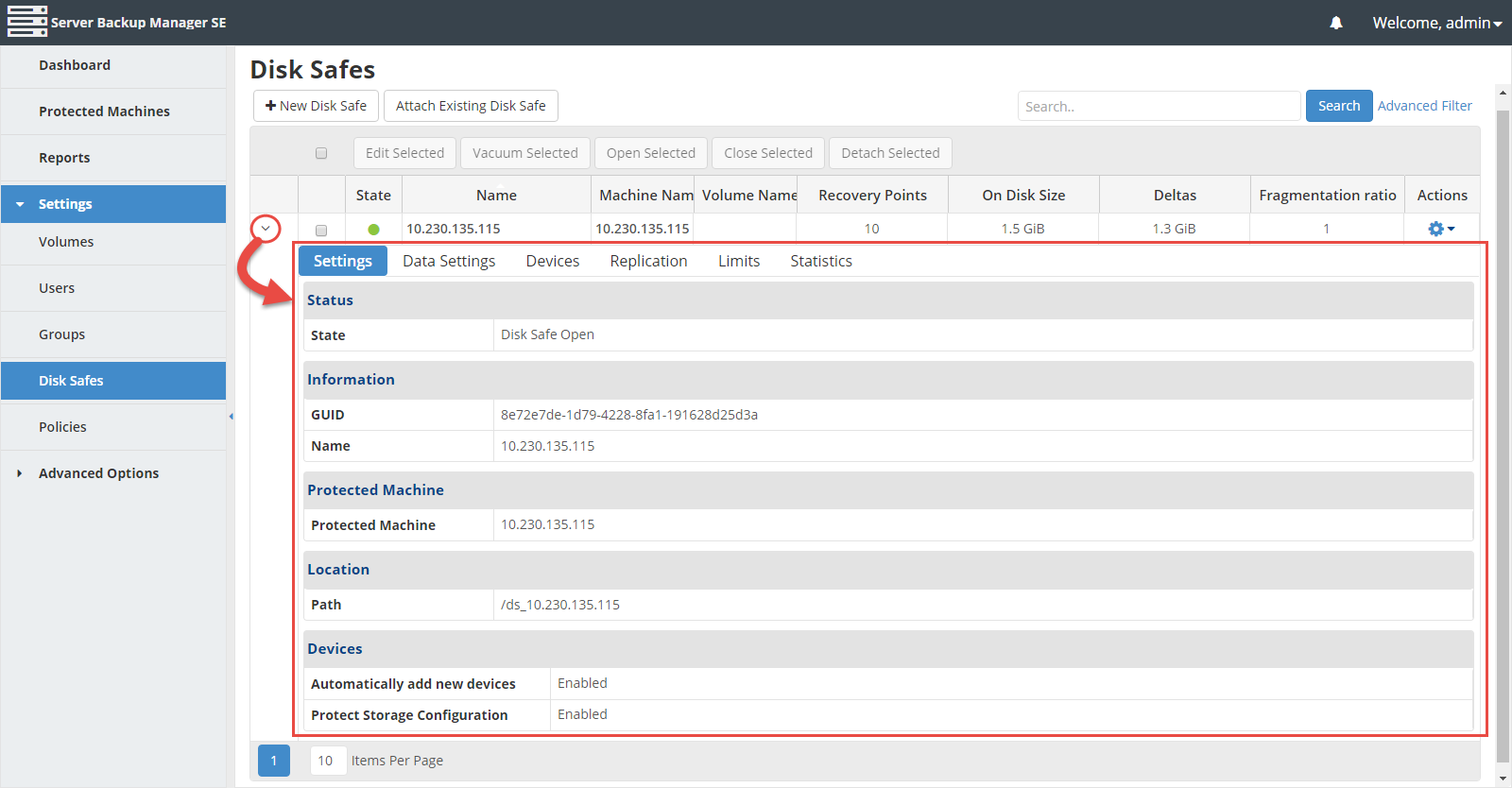
You can find more information on how to use the "Disk Safes" window in Access Disk Safes.
| Notice You need to create a Policy to replicate (back up) the Devices assigned to the Disk Safe. See Create policies. |

